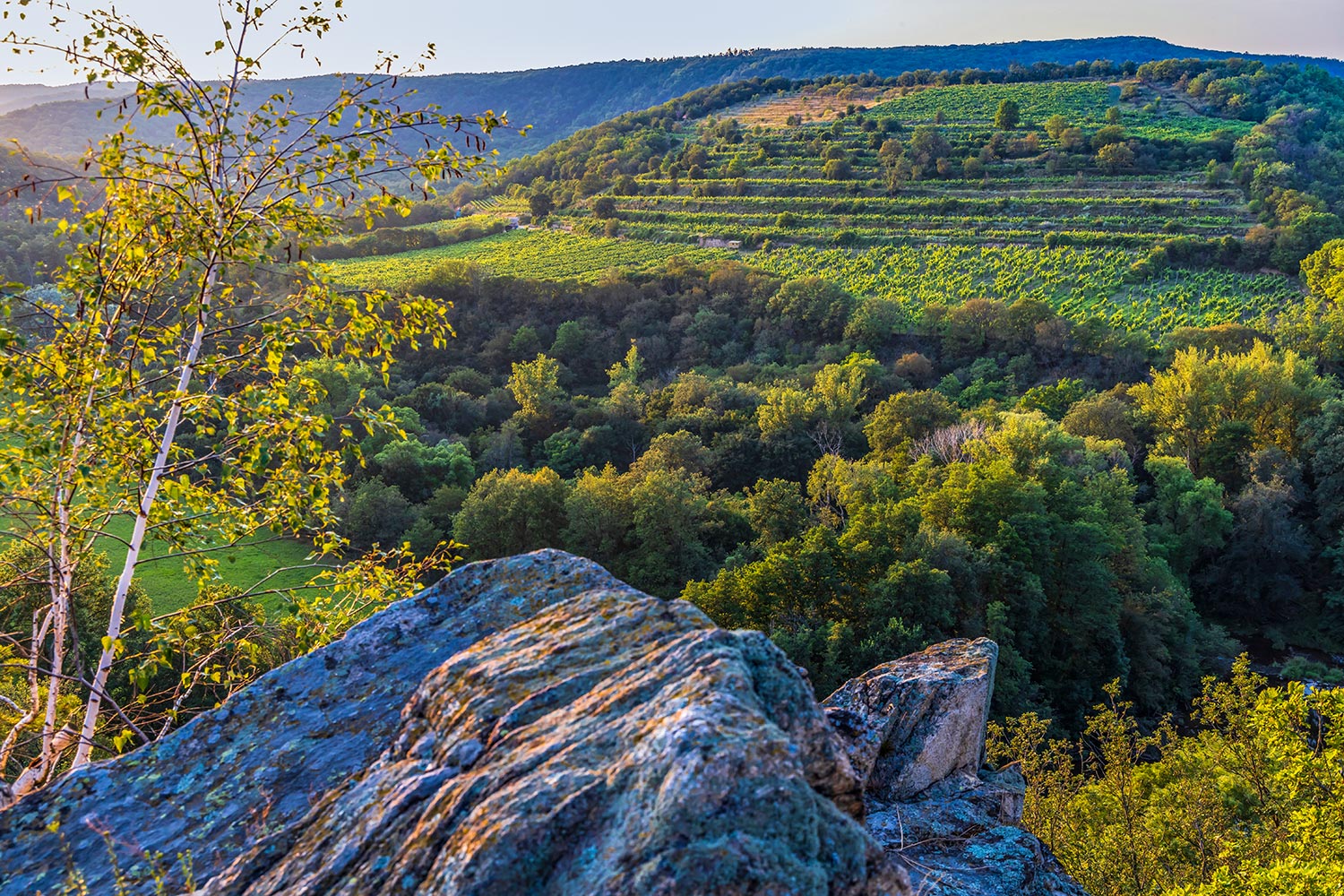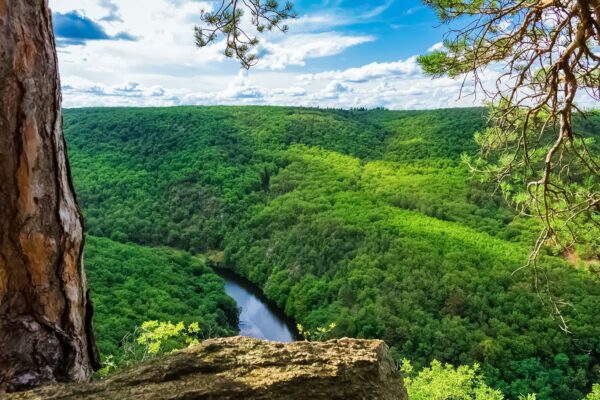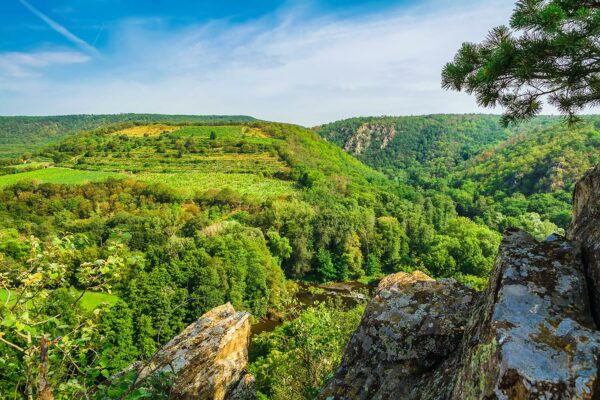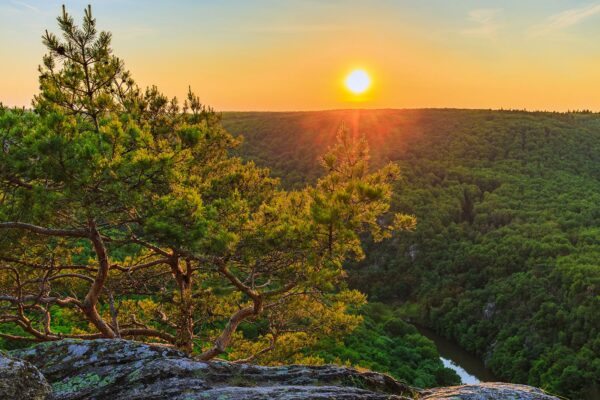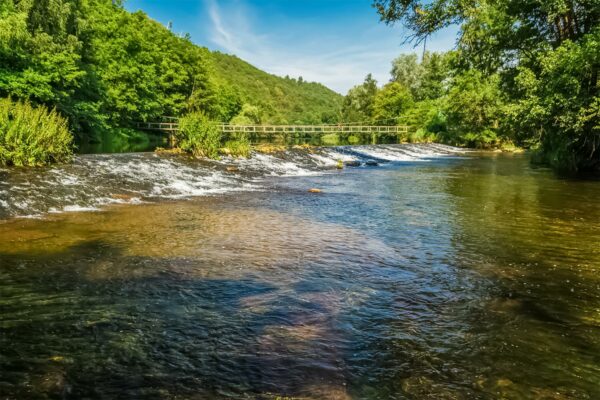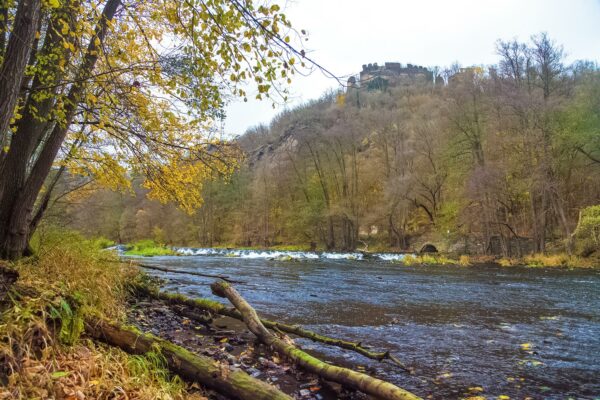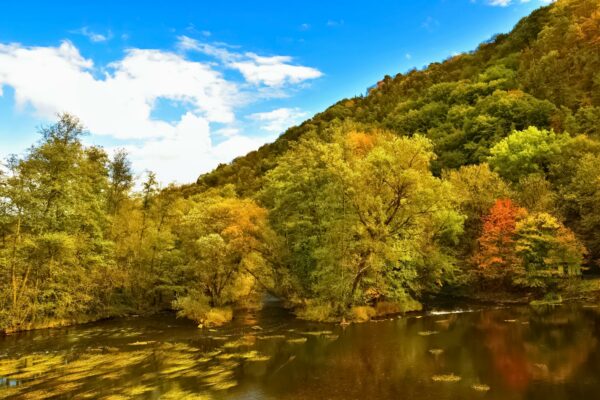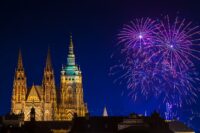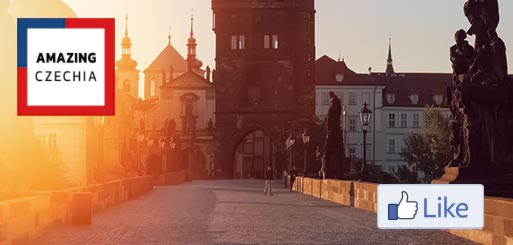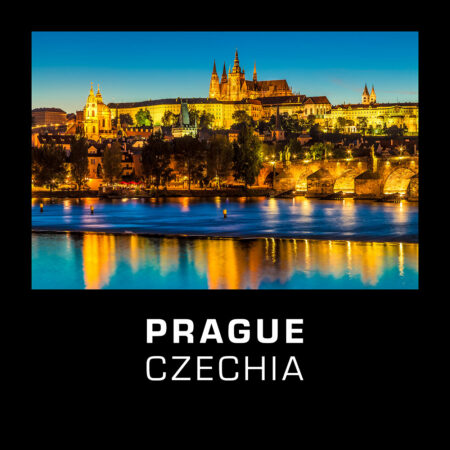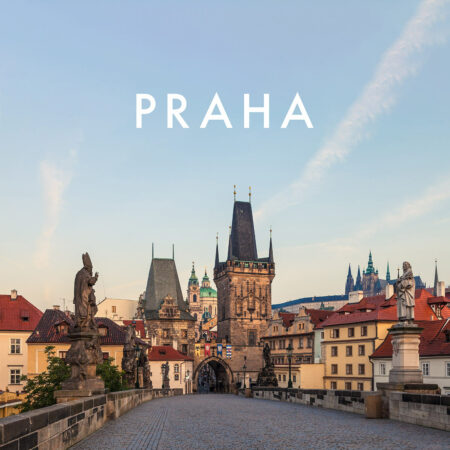Podyjí National Park is a natural protected area in the South Moravian Region situated along the border with Austria between the towns of Znojmo and Vranov nad Dyjí. Although it’s relatively small in size, it’s bursting with natural splendour. It lures travellers with its unspoiled charm, ubiquitous tranquillity, breathtaking views and hundreds of rare species of fauna and flora. Podyjí is a place every nature lover should see.
The Czech name Podyjí refers to the region around the Dyje, a river famed for its fascinating meanders and green alluvial floodplains. In German, the river is called Thaya, and hence the valley is also known as Thayatal. Podyjí National Park is the counterpart of the Austrian Nationalpark Thayatal, situated on the opposite side of the valley.
The symbol of Podyjí National Park is a black stork, gorgeous bird nestling in the natural reserve every summer. Moreover, the Podyjí is a wildlife sanctuary for tens of species of mammals. The river shores are inhabited by otters and beavers, while the shadows of the dense mixed coniferous forests offer a refuge for roe deers, foxes or wild boars.
From time to time, tweeting of the river kingfisher or howling of the Eurasian eagle-owl may be heard. The very southeastern part of the reserve is a gorgeous heath habitat spreading from Znojmo in Czechia to Retz in Austria. Other rare species of flora include e.g. Pulsatillas, Irises and Orchids.
History
The onsets of tourism in Podyjí dates back more than a century. It quickly gained popularity and, until 1948, Podyjí was a destination teeming with people wandering around and soaking up its outstanding natural beauty. There used to be many romantic mills scattered around the river, a paper factory and even a popular summer resort near the vine-carpeted hillside of Šobes. However, everything changed during the Cold War times.
In 1951, the infamous Iron Curtain, the brutal feature of the Eastern Bloc’s border defence policy, ruthlessly intersected this land and much of the River Dyje’s valley became a no-go border zone. For almost 40 years, no one, but the border patrol forces, were allowed for entry. Every cloud has a silver lining, though, and thanks to the lack of human interference, Podyjí had become a place of unique biodiversity with plenty of rare ecosystems like no other in Central Europe. In 1978, the Protected Landscape Area Podyjí was established, although most of it was still closed to the public. Luckily, the 1989 events of the Velvet Revolution heralded a new era for Podyjí.
The Iron Curtain was torn down, and the valley opened for all once again. Finally, the immense efforts to declare National Park Podyjí was materialized in the year 1991, becoming Moravia’s first and only national park. Currently, with an area of 63 km² (24.3 sq mi), it’s the smallest national park in Czechia.
Things to See in Podyjí National Park
Šobes – A unique vineyard nestled in the very heart of the national park and one of its most recognizable symbols. Šobes boasts a long tradition of winemaking, as wine has been harvested here since medieval times. Moreover, recent archaeological excavations have proven that the location was first settled about 7000 years ago. The unique microclimate of the sun-soaked southern slopes is what makes it one of the best vineyards in Europe. Local wine is known for its prime quality and delicious taste. Šobes is currently owned by the Znovín Znojmo winery and, every summer, the company offers daily wine tasting in its stand directly inside the vineyard. At the time of writing, there’re efforts made to declare Šobes a UNESCO World Heritage Site.
Getting to Šobes:
If you travel by car, park your vehicle by the Vinice Hnanice Hotel on the northwest outskirts of the village of Hnanice. Using public transport from Znojmo, exit the bus no. 818 on Hnanice’s village green. Walk northwest on the yellow-marked E8 path which will take you downhill to the depths of the valley. On the next crossroads, turn left on the red-marked trail. Traverse the slightly wobbly suspension bridge over the majestic Dyje river and enter the lovely meadow on the foothills of Šobes. Continue uphill and, after around 600 metres (650 yards), you’ll reach your destination. The cycling trail Greenways Prague-Vienna follows the very same route.
Fladnitz and Havraníky Heath (Fladnitzké a Havranické vřesoviště) – These are vast meadows covered in heath and other species of rare flowers and herbs, located near the villages of Havraníky and Hnanice, on the southeastern edge of the park.
Fladnitz Heath is one of two locations in NP Podyjí where a herd of Exmoor ponies, a breed of wild horses originally from the British isles, were released to the wild (the second area is south of Mašovice). They inhabit vast fenced pastures between Hnanice and Havraníky. Even though they’re very timid, sometimes, they can be seen – and what a delightful sight it is! However, the public is strictly prohibited from approaching, touching or feeding these fascinating animals nor jumping over the fences.
Sealsfield’s Stone (Sealsfieldův kámen) – This rocky outcrop is a fantastic place to marvel at the winding canyon below. It’s named after a renowned novelist and journalist Charles Sealsfield who was born about 3 km (1.9 mi) far from here, in the nearby village of Popice.
The King’s Throne (Králův stolec) – The place of this rather poetic name is a viewpoint located opposite the Seasfield’s Stone on the left bank of the Dyje river. Rumours have it that from this hillock, the former King of Poland John III Sobieski watched the movement of his troops across Dyje on their way to defend Vienna – hence, the name ‘the King’s Throne’. Nowadays, thanks to its easy access, it’s a popular destination for family weekend walks. There’s a wooden pavilion, a handy shelter in case of bad weather. From the parking lot on the edge of a forest near Mašovice, it’s about a 2 km (1.2 mi) long stroll.
New Castle (Nový Hrádek) – The ruins of a medieval castle perched on a tall ridge above one the Dyje’s meanders. It was built in 14th by John Henry of Luxembourg, Margrave of Moravia. For opening hours and guided tours, see the official web presentation. The closest village to the New Castle is Lukov, around 3 km (1.9 mi) far on foot.
Nine Mills Viewpoint (Vyhlídka Devět mlýnů) – Near the village of Hnanice, there’s a prime Instagram bait place. The view on Šobes is picture-perfect any time of day, but the best shots can be taken on a misty morning or during sunset. On the way to Nine Mills Viewpoint, there’s a former, closed Czechoslovak World War 2 bunker, part of the border fortification system meant to guard the southern border of Czechoslovakia. Getting there is easy - after passing the Vinice Hnanice Hotel, take the first right onto the green line. It’s around a 15-minute walk from the hotel.
Hardegg Viewpoint (Hardeggská vyhlídka) – It’s seated on the top of a steep rocky slope around 3 km (1.9 mi) far from Čížov. Looking down upon the smallest town in Austria – Hardegg – and its fascinating castle towering above the picturesque, historical settlement is a magical experience.
Blockfields (Kamenná moře) – Spectacular boulder formations remembering the most recent ice age. The greatest blockfields can be found by the Jaroslav Krejčí Way, heading from the crossroads under Šobes to the old Paper Mill (Stará papírna) and towards the Seasfield’s Stone (Sealsfieldův kámen).
Cow Hill (Kraví hora) – A grass-carpeted arid hill near the town of Znojmo with steppe-like vegetation and heath scattered around. Visitors can walk to the summit and capture the panoramic views.
Ice Caves (Ledové sluje) – These caves have been there for aeons. Their unique microclimate ensures chilly temperatures inside the cave system for most time of the year. It’s a habitat for 17 various species of bats. The subterranean labyrinth itself isn’t accessible for the public, but the surroundings are still worth a visit. Nearby, there’s a wonderful panoramic look-out with an Obelisk dedicated to the countess Helena of Mniszek.
Čížov – A quaint hamlet nestled in the heart of forests. A short section of the former Iron Curtain, nowadays a memorial, was left here to serve as a reminder of the dark past. In the southern end of Čížov, there’s the visitor centre of the National Park Podyjí, situated inside a white 3-storey building of the former border patrol.
Podyjí NP Visitors Centre
Adress: 671 02 Čížov 176
Phone: +420 515 291 630
E-mail: infocentrum@nppodyji.cz
For the opening hours, please refer to the website.
Trip Inspirations
The beautiful terrain of Podyjí is the promised land for hikers. The varied mixture of narrow paths, wide roads, spectacular strolls, scenic routes, steep slopes or impressive climbs will satisfy everybody.
One of the most popular hikes, apart of the route to Šobes, goes from Čížov towards Austria. Arriving in the village, leave your car in a free parking lot by the left side of the road. From here, you’ll have to walk on foot. The yellow-coloured path will lead you towards Podyjí NP Visitors Centre and the Iron Curtain Memorial. From here, continue on the blue-coloured path, taking you to the splendid Hardegg Viewpoint or downhill to the town of Hardegg.
Next to the bridge to Austria, there’s a building of the old Czechoslovak customhouse. At a nearby signpost, turn onto the green-coloured path and explore the mesmerizing banks of the River Dyje with a peaceful stroll. Climbing the hill will get you back on the trail towards Čížov. Note: This route, including a stop in Hardegg, is ca. 11 kilometres (6.8 miles) long, and has a vertical drop of almost 300 metres (985 feet).
Off the beaten track paths include, for instance, the E8 red-marked Smugglers’ Trail (Pašerácká stezka) which leads westwards from Čížov to the Ice Caves (Ledové sluje).
Cycling and biking routes are plentiful in the premises of the national park. The cycling paths are in good condition, and the marking is mostly well maintained.
This suggested circle route starts in Znojmo at the signpost in Koželužská street, close to the Museum of Motoring. Follow the cycling path EV13 west to Gránice Valley (Gránické údolí) and up the hill to Hradiště. In Hradiště, continue straight on the Znojemská trail towards Mašovice. Znojemská will take you to the Podmolí’s pond with a cosy pub, a perfect spot for a short break. When you get to the U milíře signpost, turn left and continue on EV13/Znojemská.
In a short while, you’ll be in Šobes, although, be advised not to rush it during the downhill - fast speed can be dangerous here! Then, continue on Znojemská towards the lovely village of Hnanice and explore its gorgeous cellar alley. Make a U-turn and return to Hotel Vinice Hranice. Turn right on Trasa šesti měst cycling path which will get you to the Havraníky Heath. Not far away from Havraníky, there’s a popular wine-tasting stand. From here, follow Trasa šesti měst all the way to Popice, Konice and across the Cow’s Hill back to Znojmo.
Note: We highly recommend riding this route anti-clockwise, to avoid the challenging Šobes climb. The entire circle is approximately 30 kilometres (19 miles) long, and the elevation is 400 metres (440 yards). It uses official cycling paths only, and it’s comprised of ca. 50% paved roads and 50% dirt tracks.
Where to Stay
Znojmo – The town of Znojmo is the main gateway to National Park Podyjí and a perfect starting point for a ton of unforgettable trips. It offers a large variety of accommodation facilities, ranging from luxurious boutique 4-star hotels to camping sites.
Vranov nad Dyjí – A touristy market town located on Podyjí’s western edge with loads of ideal places for a summer vacation, especially for avid fans of active outdoor travelling.
If you fancy a genuine rural escape, the hospitable small villages and settlements scattered around Podyjí are perfect destinations for you. Many lovely guesthouses, hostels and even hotels can be found in, for instance, Hnanice, Havraníky, Popice, Nový Šaldorf, Podmolí, Lukov or Lesná.
Amazing Places Nearby
- Znojmo - a charming town famous for its viticulture, the historical centre of south-west Moravia
- Vranov nad Dyjí - a picturesque market town
- Bítov Castle - a neo-gothic fortress on a steep hill above river Želetavka
- Šatov – a wine-producing locality boasting a picture-perfect cellar alley and remains of World War 2 fortifications


